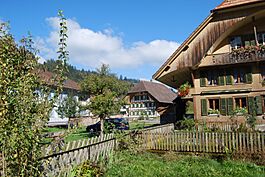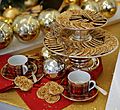Trubschachen facts for kids
Quick facts for kids
Trubschachen
|
||
|---|---|---|

Trubschachen village
|
||
|
||
| Country | Switzerland | |
| Canton | Bern | |
| District | Emmental | |
| Area | ||
| • Total | 15.65 km2 (6.04 sq mi) | |
| Elevation | 731 m (2,398 ft) | |
| Population
(Dec 2020 )
|
||
| • Total | 1,465 | |
| • Density | 93.61/km2 (242.45/sq mi) | |
| Postal code |
3555
|
|
| Surrounded by | Eggiwil, Langnau im Emmental, Trub | |
| Twin towns | Strmilov (Czech Republic), Midway, Utah (United States) | |
Trubschachen (in High Alemannic: Truebschache) is a town in Switzerland. It's located in the Emmental area of the Bern region.
Contents
History of Trubschachen
Trubschachen was first mentioned in records in 1667, called Trueberschachen. It started as a group of six farms along the Ilfis River during the Middle Ages.
At first, two nearby church areas, Langnau im Emmental and Trub, both claimed the farms. In 1666, they split the farms, with three going to each area. As the settlement grew, the farms became too far from either main town. So, in 1727, the farms started to govern themselves a little. They made their own rules about helping the poor and who could be a citizen.
A school opened in the community in 1737. Back then, the area was just known as Schachen. Later, in 1773, they set up a local police force. They also started collecting taxes between 1775 and 1777. In 1852, a "citizen's community" was formed, which meant people living there had more say in local matters. It became its own church area in 1874, and the main church was built from 1890 to 1892. Finally, in 1923, Trubschachen officially became its own town, made from parts of Trub and Langnau.
People in Trubschachen traditionally grew crops in the valley. In the 1700s, they also started weaving canvas and making cheese from milk. The first cheese factory opened in 1827. By 1900, there were five cheese factories in the town! Today, only two remain.
In 1875, a railroad connected Trubschachen to other Swiss towns. This brought new businesses to the area. In 1910, the Kambly Biscuit factory opened. It became the biggest employer in Trubschachen. Other businesses also came. Today, tourism is also important, with painting exhibitions attracting many visitors since 1964.
Besides the main Swiss Reformed church, Trubschachen also has different Baptist groups and a New Apostolic church built in 1947.
Geography of Trubschachen
Trubschachen covers an area of about 15.6 square kilometers (6 square miles). More than half of this land, about 51%, is used for farming. Forests cover about 42.7% of the area. Buildings and roads make up about 4.9%. Rivers and lakes cover about 1%, and a small part, 0.3%, is unproductive land.
The town is where the Trub River flows into the Ilfis River. It includes the main village of Trubschachen and many farms spread out along the river and up the Blapbach hill, which is about 1,000 meters (3,280 feet) high.
Trubschachen's Coat of Arms
The blazon (description) of Trubschachen's coat of arms is: Per fess Or two Mullets Azure and of the last a Tau Cross couped of the first. This means it has two blue stars on a gold background at the top, and a gold "Tau Cross" (a T-shaped cross) on a blue background at the bottom.
People of Trubschachen
Trubschachen has a population of about 1,419 people (as of December 2012). About 9.5% of the people living here are foreign nationals.
Most people in Trubschachen (about 92%) speak German as their main language. Albanian is the second most common language, spoken by about 1.8% of the population.
In 2012, children and teenagers (ages 0–19) made up about 20.9% of the population. Adults (ages 20–64) made up 56.6%, and seniors (over 64 years old) made up 22.6%.
Economy of Trubschachen
In 2011, Trubschachen had a low unemployment rate of 1.29%. A total of 987 people worked in the town.
Jobs in Trubschachen are divided into three main types:
- Primary sector: About 170 people work in this sector, which includes farming.
- Secondary sector: About 540 people work here, mainly in factories (like the Kambly Biscuit factory) and construction.
- Tertiary sector: About 277 people work in this sector, which includes services like sales, transportation, hotels, restaurants, healthcare, and education.
Many people who live in Trubschachen also work there. In 2000, about 45.2% of the workers both lived and worked in the town. About 11.4% of workers use public transportation to get to work, and 40.2% use a private car.
Religion in Trubschachen
Based on a 2000 survey, most people in Trubschachen (about 74.5%) belong to the Swiss Reformed Church. About 5.1% are Roman Catholic. Other Christian churches make up about 5.3% of the population. About 3% of the people are Muslim. There are also smaller numbers of Buddhists and Hindus. About 3% of the population do not belong to any church.
Education in Trubschachen
In Trubschachen, about 48.6% of adults have finished high school (called "upper secondary education" in Switzerland). About 11.5% have gone on to higher education, like a university or a specialized college.
The school system in the Canton of Bern starts with one year of optional Kindergarten. Then, students go to six years of Primary school. After that, they have three years of mandatory "lower Secondary school." In this school, students are grouped by their abilities. After lower Secondary, students can choose to continue their education or start an apprenticeship (learning a trade on the job).
During the 2012–13 school year, 156 students attended schools in Trubschachen. This included 24 students in kindergarten, 95 in primary school, and 37 in lower secondary school. Some students in Trubschachen's schools were from other countries or spoke a different language at home.
Sister Cities
Trubschachen has a special friendship with another town called Midway, which is in the state of Utah in the United States. They are called "sister cities."
Notable People
- Georges Huber (1910–2003): He was a Swiss journalist born in Trubschachen. He wrote many articles about the Catholic Church.
Images for kids
See also
 In Spanish: Trubschachen para niños
In Spanish: Trubschachen para niños












